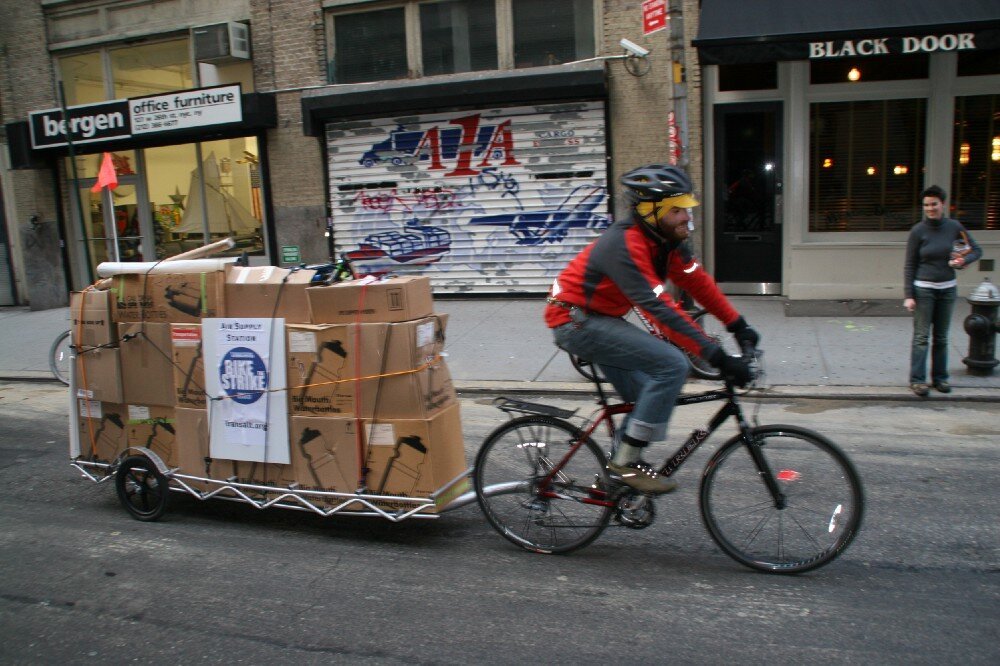Bikes keep NYC rolling through hard times
There was a 500 percent increase in cycling during the 2005 Transit Strike.
In a time when so many New Yorkers who normally depend on public transit are trying to avoid crowds, bikes have become an invaluable way to get around. While some of us are lucky enough to be able to shelter in place and work from home, many of the frontline workers who must be out during the COVID-19 pandemic are reliant on bikes. Right now, New Yorkers are using bikes to make essential trips to the grocery store, get exercise, help others through mutual aid, and commute to work while maintaining the critical physical distance that keeps us all safe.
Bikes have been top-of-mind for many New Yorkers since this crisis first hit our city. Back in early March, there was an initial surge in cycling as people opted out of taking transit. Cycling increased by 50 percent over the East River bridges, and Citi Bike ridership shot up. In the following weeks as more of the city shut down, delivery cyclists became frontline workers, and the state legalized the e-bikes that many of these workers use to get around. Groups like Citi Bike, bike companies including BikeRentNYC and Specialized, scooter companies like Revel, and our own #BikeMatch program all moved to get wheels to people who needed them most. And last week, New York City began its push to open 100 miles of Open Streets, making room on the street for cyclists and pedestrians to make essential trips while maintaining physical distance.
It’s not a surprise to us that bikes have been such an integral part of New York’s response to the pandemic. Over the years, as New York has faced and overcome crisis after crisis, we’ve seen firsthand the power of bicycling in response and recovery efforts. And as an advocacy organization that pushes for safer streets and more transportation options for New Yorkers, TA has long helped power bicycle-led relief efforts, devised emergency transit action plans, and pushed for the rebuilding of key infrastructure in response to hard times. The more we plan for a future in which cycling is a safe, viable, and convenient transportation option, the more resilient our city will become.
Superstorm Sandy: Mutual aid on two wheels
Occupy Sandy used bikes to deliver medical care to affected communities.
Giant, Recycle-A-Bicycle, and TA teamed up to bring 100 bikes to people in need.
In the fall of 2012, Superstorm Sandy wreaked havoc on New York, upending the lives of millions of New Yorkers and severely damaging our transit infrastructure. New Yorkers soon began organizing relief efforts to bring medical care and supplies to affected communities. To add pedal power to the relief efforts, Transportation Alternatives, Giant Bicycles, and Recycle-A-Bicycle came up with Ride NYC Forward, a plan to put bikes in the hands of New Yorkers in need. Giant donated 100 bicycles, Recycle-A-Bicycle built the bikes, and TA distributed them to those in need. The bikes were given to affected residents to help them get around, and to Occupy Sandy volunteers providing medical aid in Brooklyn and the Rockaways.
In response to the heavily damaged regional transit network, TA put forth a transportation relief plan to assist stranded New Yorkers, prevent gridlock, and ensure there was enough space for walking on bridges and major streets.
The 2005 Transit Strike (and bike spike)
In December 2005, the Transport Workers Union Local 100 striked against the MTA, shutting down New York’s subways and buses for more than three days. To control gridlock, the City put rules in place requiring cars entering Manhattan to have at least four occupants, and closing select avenues for emergency vehicles. For many subway and bus commuters, biking was the best way to weather the transit strike: despite December’s frigid temperatures, there was a 500 percent increase in bike ridership, including many first-time riders.
During the strike, TA was a resource for cyclists.
Before the strike began, TA put together a Transit Strike Action Plan offered tips related to bike paths, river crossings, and bike parking for new riders. As the strike became imminent, TA launched “Bike the Strike” as a one-stop resource for transit news and bike help for the influx of inexperienced cyclists. Even as the strike ended, TA saw the potential for a better biking city and put forth a plan for better infrastructure so New York could continue to reap the benefits of biking.
Post-9/11: Response and recovery in Lower Manhattan
In the days and weeks following 9/11, biking became a key form of transportation for many New Yorkers. Cars entering Manhattan were being carefully searched causing backlogs of traffic, at the Queensboro Bridge delays ranged from two to three hours. This led many New Yorkers to try cycling. The East River Bridges saw a 30 percent increase in bicycle traffic and while other retail shops saw a drop in sales, bike shops reported a significant increase. Security measures barred cars below Canal Street and pedicabs filled Lower Manhattan to provide transportation.
In the wake of the attacks, TA worked alongside partners in the Empire State Transportation Alliance to put out a Post Disaster Relief Plan to improve transit and cyclist access to downtown Manhattan. In the long term vision of rebuilding the city, TA developed and proposed plans for New York’s transportation future: increasing security, expanding transit, and implementing congestion pricing.
Though COVID-19 is different from any crisis New York has faced, it’s clear that the need for safe, reliable and flexible transportation becomes even more essential during these moments. The fact is that bikes and bike infrastructure remain a lifeline for many of us, particularly in times of crisis. If we want our city to be resilient, safe and able to weather future disasters, it would serve us well to plan for a future in which biking is an option for all New Yorkers.




